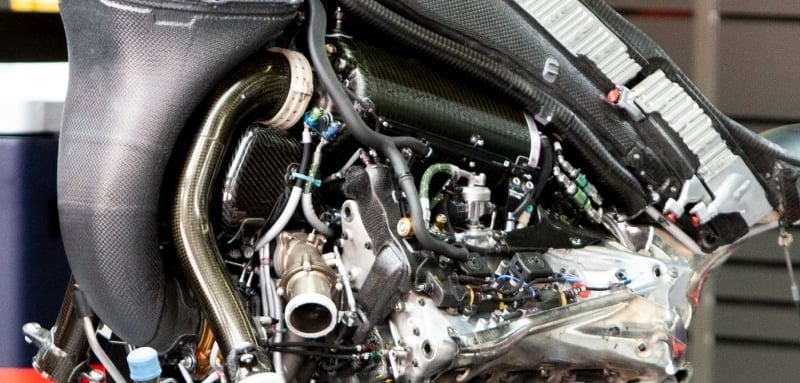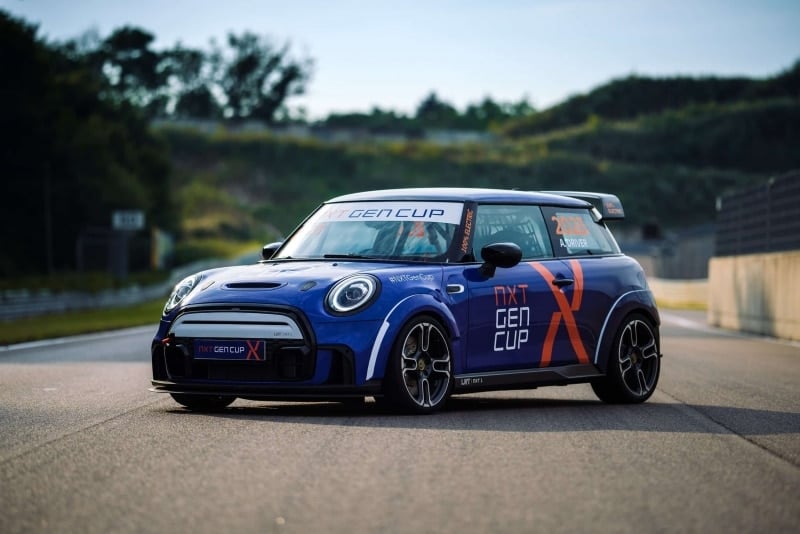This week in the Sustainable Motorsport Roundup I look at everything from a new concept for a more sustainable Formula 1 to an electric muscle car. Along the way I bring you details on the new F1 power unit, Brabham Automotive, the World eX Summit, green racing tires, sustainable luggage and more. So, let’s get started!
Sustainable Motorsport News
- PMW Magazine presents a fascinating look at what Formula 1 could be in the near future. In The F1 regulations proposal that lays out a path to technological freedom, they look at the proposal outlined by Phantasia Consulting that proposes something I have long been an advocate of. The paraphrased quote attributed to Pat Symonds in the article best sums up this approach: “give us a budget and a box to design the car in, leave the rest up to us”. The interesting part of the proposal focuses on the power unit. “In among some florid language about the golden eras of racing, the core of Phantasia’s proposal is that F1 should be a straight fight of who can go the fastest with the same amount of energy. In this case, the equivalent of 200kg of gasoline for the whole weekend (50kg for practice, 50kg for qualifying and 200kg for the race), with teams free to use ICE, hydrogen (they do not specify fuel cell or ICE), electric or any combination of the above. Refueling in races would not be allowed. Budgets would be capped at US$135m per year, and any powertrain manufacturer must make its system available to anyone on the grid for US$15m.”
- The Brabham name was a force to be reckoned with at one time in Formula 1 but it then faded into obscurity. Autosport looks at son David’s plan for the marque now that he has wrestled control of the name back with the family in How one of F1’s greatest names was revived. Interestingly, sustainability is a big part of his plans. “The issue for Brabham Automotive as a fledgling company is that there are so many possible avenues. Electric power, hydrogen, synthetic fuels, hybrids could all be viable routes. “The biggest challenge is to know where to put your resources – what is actually going to work,” confirms Brabham. “I’ve heard certain manufacturers say they’re going electric and then the realisation is actually maybe electric might be part of the solution but it’s not all of the solution. You’re going to have different options and each option requires a significant amount of investment. There are lots of channels you have to think about and invest in.”

- In last week’s Sustainable Motorsport Roundup I mentioned the World eX Summit that took place last weekend. In the video above, you can watch highlights from what happened over what looks like an exciting and innovative day.

- At the World eX Summit, Sebastian Vettel made a surprise appearance and argued that F1 should reinvest their profits into race promoters so that they can put on greener events. “In the end we need to take some of the sort of turnover or money that Formula 1 in particular makes and try and reinvest to the promoters and give them the chance to decide for a better, greener, cleaner solution when it comes to handling crowds and dealing with the event.” You can watch his complete appearance in the video above.
- In Porsche and Audi will have to raise their games for F1, The Race looks at the implications of Porsche and Audi going to F1 for the entire motorsport ecosystem. “Do the LMDh plans follow Audi’s and get shelved? Will the classic boom-and-bust endurance racing cycle end up in an even deeper trough next time around? And will the crest of the F1 wave just keep peaking and mean manufacturer bean-counters keep finding it irresistible? Combine those two things and potentially the effects for other strands of the sport, Formula E included, could be very difficult indeed between 2026 and 2030, which is ironically the date where multiple governments are scheduled to hit varying EV quota targets.”
- On Dow’s Seek Together Podcast, Episode 2 looks at the future of mobility. “On this episode of the Seek Together Podcast, our host Eva Saha is joined by Tim Boven, Global MobilityScience™ Director at Dow, and James Barclay, Jaguar TCS Racing Team Principal and Managing Director, Jaguar Land Rover Motorsport, to discuss what the future of mobility holds. They discuss the role of materials science to tackle challenges and capitalize on opportunities presented by the electrification of vehicles. Together, they explore the megatrends of automotive innovation and explain the dynamic connection between innovation for Formula E racing cars and the evolution of consumer vehicles. Motorsport is both the catalyst and platform for cutting-edge innovation in mobility. From its earliest days, racing has provided an exciting and important testing ground for the industry’s latest prototypes and a demonstration of how experts come together to create best-in-class performance vehicles. On this episode, Jaguar TCS Racing gave us a glimpse ‘under the hood’ at the cutting-edge innovations that helped them make history with a second-place team finish in the 2020/2021 ABB FIA Formula E World Championship, and how both the seen and unseen race car improvements that led to a record-breaking season can be scaled and integrated into our own future vehicles.”
Series News

- The FIA has finalized the 2026 Formula 1 power unit regulations with as expected the MGU-H being dropped and tighter constraints on the ICE design. Adam Cooper looks at the concessions made to get Audi and Porsche into F1. One interesting point that the FIA made about this PU that the FIA has made is that: “Fully sustainable fuel is a cornerstone of the 2026 regulations and all fuel components must come from sustainable sources – either non-food-bio-derived, from genuine municipal waste or from sustainable carbon capture.”
- F2 is set to keep its current grid size and will introduce a new engine in 2024 that will run on sustainable fuels with the possibility of going hybrid in the picture. “Interested engine builders need to be able to run their designs on a 55% mix sustainable fuel for the duration of the three-year contract, and the FIA and F2 promoter Formula Motorsport Limited intend that if that contract is renewed into the 2027, ’28 and ’29 seasons then by the end of that a 100% sustainable fuel will be in use in the series. Hybrid compatibility is also not detailed in the published document, but it is understood that following Formula 4 and Formula Regional’s capacity to add hybrid components within their Gen2 chassis, there is the intention that FIA Formula 3 and F2 will do the same with their next generation of cars even if no hybrid units are ever actually added.”

- Bridgestone debuted a new IndyCar tire at the recent Big Machine Music City Grand Prix in Nashville, Tennessee, which uses a sidewall made with natural rubber derived from the guayule desert shrub. PMW Magazine looks at the tech behind the tire.
- In What Formula E needs next after saying goodbye to Gen2, Autosport Plus author Jake Boxall-Legge offers his take on the good and the bad facing Formula E as they head into the Gen3 era. “The 2021-2022 Formula E season finale brought the curtain down on the Gen2 era of the all-electric world championship. It elevated FE to new heights, fulfilling its intended directive. While it is a good launching pad for the impending Gen3 cycle, there are certain aspects the series must tackle for the new era to have the same impact as its predecessor.”

- Testing continues in Sweden for 2023’s NXT Gen Cup and their electric LRT NXT1. You can view video of the car in action at Gelleråsen here.
- Dirtfish asks the question: Has World RX missed an opportunity with electric revolution? “World Rallycross’ move to an all-electric formula has been a long time coming. First mooted in 2016, the exact make-up of what rallycross’ electric formula would be has undergone several revisions since then, with the series eventually settling on an uninspiring cocktail of a spec pre-prepared electric drivetrain that, for the most part, was retrofitted into existing vehicles developed for the old Supercar (later RX1) ruleset. Meanwhile Nitro RX – a series that didn’t even exist two years ago – has designed, developed, and produced a fleet of cars from the ground up that are not only more powerful, but quicker too.”
Sustainable Motorsport Tech
Some of this tech is not currently directly related to motorsport, yet. But it gives you an idea of some of the developments that are taking place fast and furiously in sustainable transportation.
- Autoweek looks at How Climate-Friendly Gasoline May Yet Have a Place in Our EV Future. “Could the remaining tailpipes be given a pass if they’re powered with carbon-neutral electrofuel (e-fuel), essentially synthetic gasoline or diesel built up from a combination of renewably produced hydrogen from water via hydrolysis and captured carbon dioxide (CO2)? Some European automakers are saying yes.”
- According to Drive (and reported in Jalopnik), while Lamborghini will unveil its first hybrid model in the coming years, the company hopes to keep its V10- and V12-powered cars running on synthetic fuels in the future. The site reports: “Lamborghini has joined the race to develop environmentally-friendly synthetic fuels – pitched as carbon neutral, with cars only emitting CO2 that has already been removed from the environment – in response to customer demand, to help its petrol engines to live on into the electric future.”
- Porsche meanwhile is continuing their look at multiple propulsion technologies including hydrogen. In a recent study, Porsche Engineering has examined the potential of hydrogen combustion engines. The result is a high-performance powertrain with emissions at the same level as ambient air. “The hydrogen engine is unlikely to enter production in its current form, but that wasn’t the goal of the project anyway. Instead, the focus was on examining the technical potential of the alternative drive technology and expanding the capabilities of existing engineering tools. “The study allowed us to gain valuable insights with regard to the development of high-performance hydrogen engines and add models and methods specifically for hydrogen to our virtual simulation methodology,” explains Bevilacqua. “With this know-how, we are ready to efficiently handle future customer projects.”
- When it comes to hydrogen, color does matter. Sustainability For All explains why green hydrogen is the only alternative. “The problem for now is that grey hydrogen is the most widespread, and blue hydrogen positions itself as another option that is slightly less bad than the previous one. So, at this point, when it comes to hydrogen, the only viable, clean and sustainable possibility is green hydrogen.”
- Autoweek looks at the new Dodge Charger Daytona SRT concept car was recently introduced which includes some very interesting tech for what is described as an electric muscle car. Dodge didn’t disclose the powertrain, but it operates on an 800-volt system and uses a multi-speed electro-mechanical transmission. What about the sound? “Besides the multi-speed transmission, this Dodge EV concept has an exhaust system, sort of. Clearly, there’s no combustion, so it’s not technically an exhaust pipe. Dubbed the Fratzonic Chambered Exhaust, this system replaces the traditional exhaust note with a facsimile. Without revealing details—again—Dodge says it’s not just a speaker churning out simulated combustion noise. It’s likely some sort of pump that pushes air through a device to generate sound. In a world of nearly silent EVs, Dodge promises this one will be loud: 126 dB—that’s the same peak noise rating as your current Charger SRT Hellcat.”
- While Dodge goes with the simulated sound approach, Lamborghini’s new CTO promises that they definitely won’t play a fake V10 sound. “Ask me how we will do this and I cannot answer 100%, because we are still working on it,” he continues. “We can analyze the frequencies that are available and look to eliminate some and enhance others. Then there are some vibrations, maybe imperfections in the transmission. Beyond that there are opportunities to sound-engineer the motors, but to develop what is already there rather than create an artificial one.”
Every Little Bit Counts

It is easy to get overwhelmed in negativity when reading the news about climate change. The problem seems so big that it is hard to focus on what one person can do and make a difference, however small. This is why I write Every Little Bit Counts because small gestures by individuals do add up.
- For example, in the photo above, Formula E driver Lucas di Grassi is shown arriving in London with his Solgaard luggage. His backpack and luggage are made of ocean plastic and each piece will reduce about 200 bottles from reaching the ocean. While di Grassi is admittedly an investor in the company, according to him “the quality is amazing and the price competitive. There is no reason not to be your next travel gear.”
- While I often focus on sustainability initiatives involving global logistics via planes, ships and trucking, there are options available for local travel. Take for example Ferry, a company that allows you to rent an EV (similar to Uber) that can be anything from a Tesla to an electric scooter. Or how about Revel that offers something similar? There are options and they are growing every day.
The point is that we can make significant contributions in reducing our impact while still allowing us to do those things we love, like getting to the track sustainably or meeting up with a sponsor for a discussion on extending their sponsorship with you. Every little bit counts.
The Big Picture
- Sport Pro Media have published Part 2 of their Sport For Good Playbook. In part two they dive into how brands rationalise their purpose investments. “In business, commercial growth and sustainability have often been seen as separate things. Even today, many executives view sustainability as too complex or costly to implement, while some believe initiatives designed to help organisations become more sustainable simply aren’t profit-generating. Such myths abound, particularly in sport where short-term profitability and immediate results are paramount, yet a growing number of C-suite decision-makers are beginning to realise how sustainability can create long-term and measurable value for their business.”


